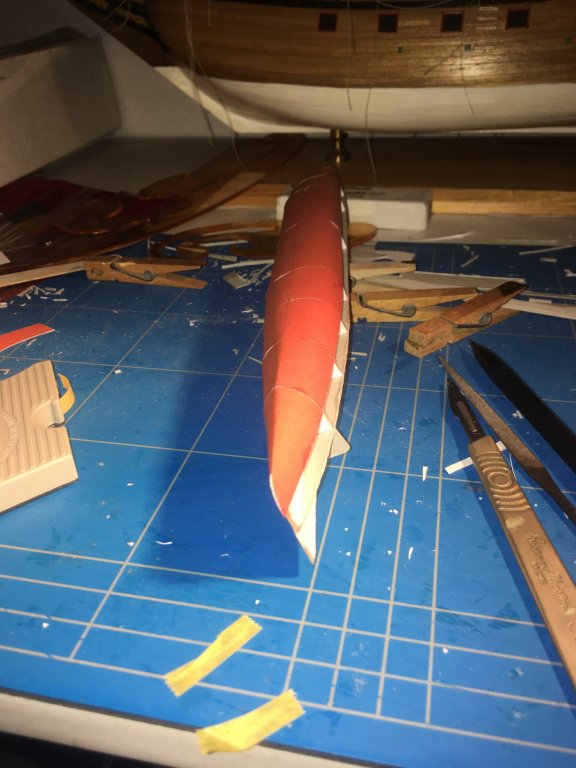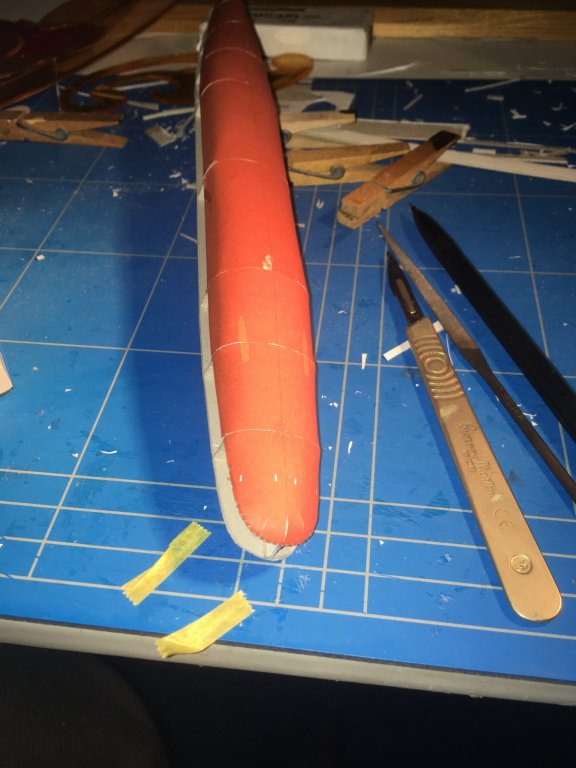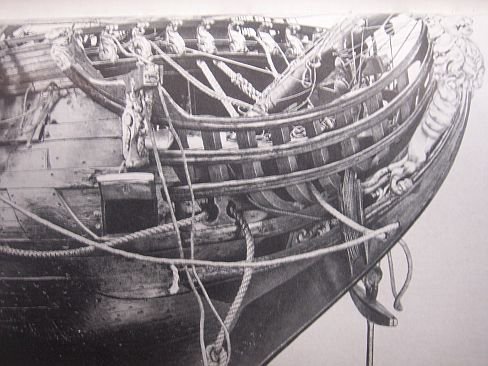-
Posts
3,485 -
Joined
-
Last visited
Content Type
Profiles
Forums
Gallery
Events
Everything posted by amateur
-
And don't forget that the lion has two tails (between his legs...) there is a Dutch saying: 'going with your tail between your legs', which means so much as 'leaving as you know you're beaten.' Fits in quite well with his facial expression. Someone had some fun I guess... Jan
- 305 replies
-
- utrecht
- statenjacht
-
(and 1 more)
Tagged with:
-
I actually wouldn't want to behave it like that: it will crumble ...... I checked my pics with (parts of) the lion. Not overly sharp :(, but I guess you can see enough on it. (Long time ago we had someone on MSW building a cardboard-version of the Utrecht, and he asked me to get pics of the carving details. I have some more on other parts, if you like) Jan
- 305 replies
-
- utrecht
- statenjacht
-
(and 1 more)
Tagged with:
-

JU-287 by Lucius Molchany - 1/48 - PLASTIC
amateur replied to Lucius Molchany's topic in Completed non-ship models
I'll never get used to that 'wrong direction' of the wingtips Jan -
Reading about these things does not have the impact as seeing it happen..... Jan
-
Is that total barrel lenght, or measured from the pont where it comes free of the mount? jan
-
I guess you checked maritiemdigitaal on any interesting pics? http://www.maritiemdigitaal.nl/index.cfm?event=search.getsimplesearch&database=ChoiceMardig&needimages=true&searchterm=Kruiser java&allfields=&title=&keyword=&creator=&collection=&shipname=&invno=&museum=&startrow=1 problem is that their searchengine isn't too good. Searching dor hrms java dosnt give too many hints, while searching for Java gives way too many I searched for kruiser java, which gives a nice bunch of pics. Jan
-
Just a question: if this result is labelled 'quite acceptable' how on earth does '(near) perfect' look like? If ever my results came out half as good as this, I would be very, very happy indeed..... Jan
-
Tbit late, I had a number of pics uploaded in picasaweb. I can't give a link to these as google decided to stop the service. I'll have a look at home, check wether or not I can upload them The grey thing the lion is holding is the sign of the cityof Utrecht (red and white) Jan
- 305 replies
-
- utrecht
- statenjacht
-
(and 1 more)
Tagged with:
-

Rigging lines located inside of shrouds?
amateur replied to Mickgee's topic in Masting, rigging and sails
Quite a number of lines going through the masttops (check eg EdT's build log of America), down to the railings. Therefore the mast area is crowded, but sail handling is more efficient from down under: no need to send up large amounts of sailors high up in bad weather: sail adjustments could be done from deck level. Also: you cabn get more men to a line when the line is all the way down to the deck: the number of people that fit on a top is relatively small. So yes, there is a reason (and it was standard practice from quite early on: also 16th century rigging also had this practice) Jan -
Yip, solvent one. I discarded the pva, as it tended to leave visible changes in the card due to rhe water, might switch back to PVA though, below the promised pics: bow and stern closed. No problems (apart from fingers wirh glue )
- 64 replies
-
- v108
- digital navy
-
(and 2 more)
Tagged with:
-
Finally, found some time to work on the hull. again a learningpoint: find some acceptable glue. this one tacks easily, but is rather thick, and is setting too quick, resulting in those nastly 'threads' of dry glue when applied with a small applicator. now I have to fins my pics.... (I took them, but where did I leave them ...) Jan
- 64 replies
-
- v108
- digital navy
-
(and 2 more)
Tagged with:
-
And I think it is not only fresh air for those working over there. I don't know how many fires there were to keep the steam pressure on. Coals also need some air to burn Jan
-
No plastic, no PE, no airbrush. Don't you feel a bit off your feet ? Jan
- 455 replies
-
- slightly modified
- greyhound
-
(and 1 more)
Tagged with:
-
Yup, as far as I understand the business of model building, there are two ways to go with a kit: just plain out-ot-the-box without thinking, or discarding parts (sometimes very large parts) of it, and just try to improve on the kit. Some even say that that second route will inevitably lead to model building without kits. But look on the bright side: three years of fun from one box. That is not too bad Jan
-
I checked Witsen He describes grating as you made them: the lower layer, measured about two inches high, two wide, the upper layer nailed on top, battens half inch thick, about 3 inch wide, I guess the lower layer is around two-three inches apart. so you would be correct, as soon as you follow the advice of Hans: sand back until zero thickness jan
- 91 replies
-
- kolderstok
- duyfken
-
(and 1 more)
Tagged with:
-
A grating expert? What do you want of him? Jan
- 91 replies
-
- kolderstok
- duyfken
-
(and 1 more)
Tagged with:
-
btw The foto is from the book by Heinrich Winter, describing the model of a Dutch 80 guns ship. (model lost in the war...). Mamoli based its model on the book and the drawings that came with it. Jan
-
The plan is correct, but due to the form of the bow, you'll notice that the planks will have a severe tendency to do what you see on the foto. There is one thing where the plan is not correct (actually, more, but this one is easy to correct): The hawseholes are one wale too low: the should give acces to the main gundeck, the way they are drawn now, ends up below the deck. Jan
-
Nope, straight from the printer.... will have a look in the shop. Jan
- 64 replies
-
- v108
- digital navy
-
(and 2 more)
Tagged with:
-
Took me some time, but today I managed some work last week i doubled all frames (below waterline). next I attached the first bottom plate. Put it in model by rolling it on the inside with my x-acto knife handle, on an oldfashioned (foam) mousemat. Worked perfect after the glue tacked, IPutthe second skin on. It almost fitted some disaapointment when I removed the tape, after drying. Somehow the colour sticks to the tape. Glue residue, sooemthing to do with my print, I dont know. Need for touch-ups ... and I had a very small overlap at the corner. I cut a very small sliver away, but in the end that turned out to be a chunk that was way too large. Some need for touch up.... I will dollow the kit in making an overlap between the lower and the upper hull. Butting red aginst grey seems to be too much of a ask for me. apart from the need for touch-up, I am not too disappointed: some slight starving cow effect, but not too much. All other skins are curved, angled and otherwise problematic, so I keep my fingers crossed Jan
- 64 replies
-
- v108
- digital navy
-
(and 2 more)
Tagged with:
-
Exactly how much do you use from the kit itself? it looks as if you replace almost everything Jan
-
Does your scan/print sequence result in acceptable colours? Last time I needed such an action, it took me several tries to get the colour right .... Jan
-
And for those followers who do not know. Here you can find them. 39 rather detailed drawings. http://www.gahetna.nl/collectie/archief/ead/index/zoekterm/Marine tekeningen/aantal/20/eadid/4.MST#c01:0. I can not give a direct link to Java, go to entry 1.2.21, there they are (as well as drawings of some other famous ships) I like the longitudinal section: you can almost put it to you wall as art: http://www.gahetna.nl/collectie/archief/inventaris/gahetnascans/eadid/4.MST/inventarisnr/3528/level/file Jan
About us
Modelshipworld - Advancing Ship Modeling through Research
SSL Secured
Your security is important for us so this Website is SSL-Secured
NRG Mailing Address
Nautical Research Guild
237 South Lincoln Street
Westmont IL, 60559-1917
Model Ship World ® and the MSW logo are Registered Trademarks, and belong to the Nautical Research Guild (United States Patent and Trademark Office: No. 6,929,264 & No. 6,929,274, registered Dec. 20, 2022)
Helpful Links
About the NRG
If you enjoy building ship models that are historically accurate as well as beautiful, then The Nautical Research Guild (NRG) is just right for you.
The Guild is a non-profit educational organization whose mission is to “Advance Ship Modeling Through Research”. We provide support to our members in their efforts to raise the quality of their model ships.
The Nautical Research Guild has published our world-renowned quarterly magazine, The Nautical Research Journal, since 1955. The pages of the Journal are full of articles by accomplished ship modelers who show you how they create those exquisite details on their models, and by maritime historians who show you the correct details to build. The Journal is available in both print and digital editions. Go to the NRG web site (www.thenrg.org) to download a complimentary digital copy of the Journal. The NRG also publishes plan sets, books and compilations of back issues of the Journal and the former Ships in Scale and Model Ship Builder magazines.





